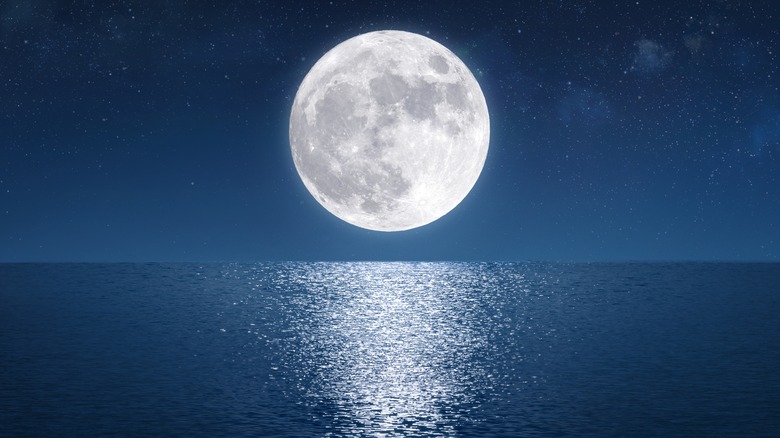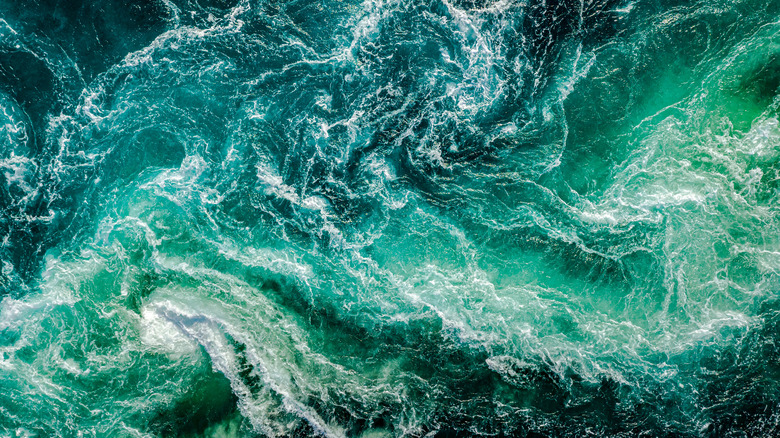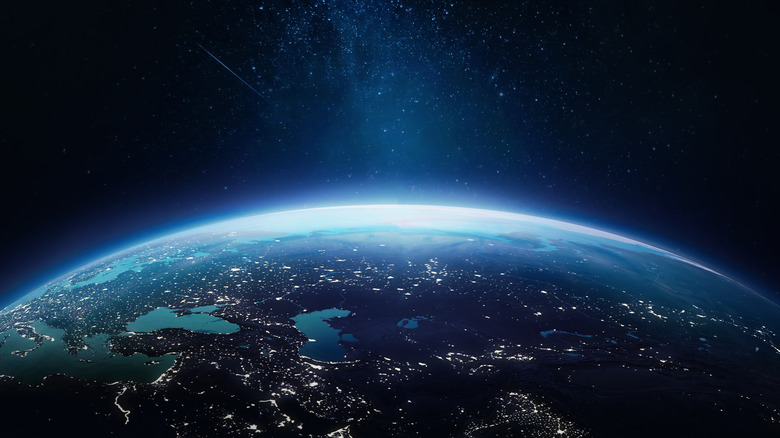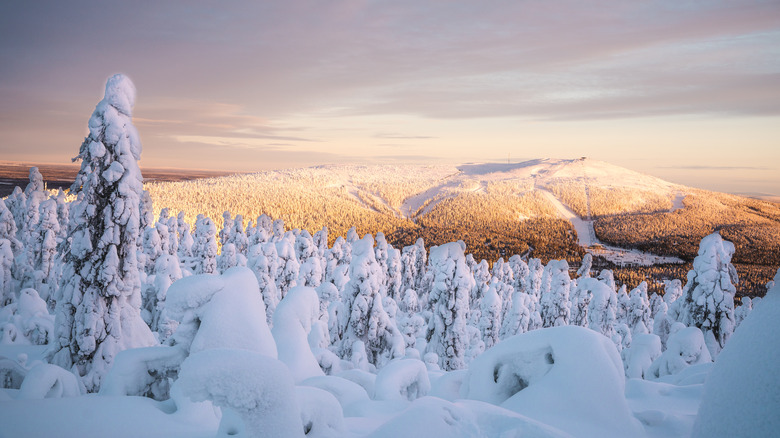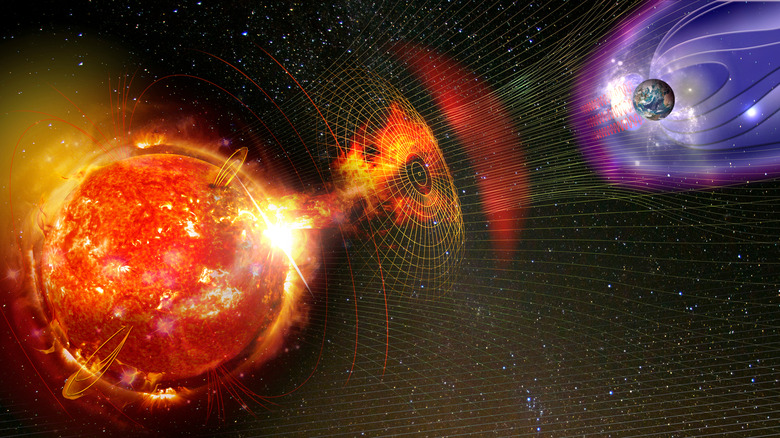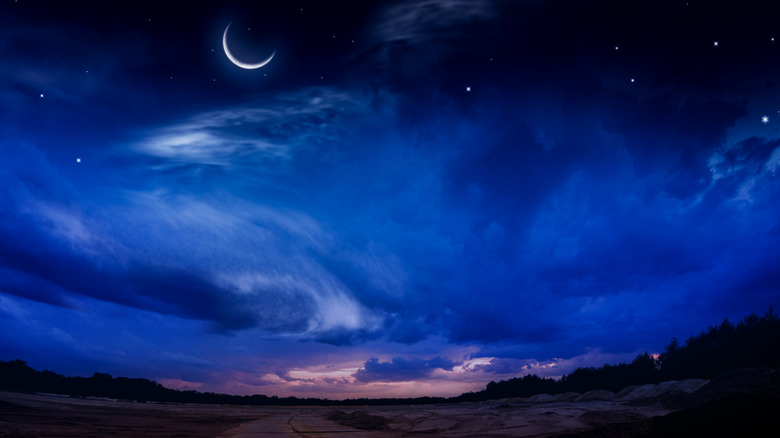Why The Moon Is So Critical For Life On Earth
"Art thou pale for weariness / Of climbing heaven and gazing on the earth / Wandering companionless / Among the stars that have a different birth." Such a gorgeous poetic verse from Romantic poet Percy Bysshe Shelley's "To the Moon" just about begins to do justice to Earth's most stalwart celestial companion (per Poetry Foundation). Our moon and its beauty have inspired countless poems — its expanding and shrinking cycles have linked it to the womb, pregnancy, and motherhood (discussed a bit on HuffPost), and its presence in the night sky has made it critical to mystical and astrological traditions (per the Independent).
But when Shelley wrote "To the Moon," he also hit on some of our rocky satellite's more measurable, scientific properties — namely, that it has "a different birth." At present, many researchers agree that the moon formed when the Mars-sized protoplanet dubbed Theia collided with Earth some 4 billion years ago, as Inverse explains. Part of Theia got embedded inside Earth, and parts of both planets spun off to form our very unique moon. The moon is much larger in proportion to the Earth than the moons of other planets, is tidally locked so one side always faces us, and, unbelievably so, is exactly the right size and distance to allow for solar eclipses, as sites like NASA and the Institute of Physics explains. But far more importantly, the moon is fundamental to the existence of life on Earth. Without it, we might not be here at all.
At the cusp of life
When we say that life on Earth wouldn't exist without the moon, we mean it completely non-hyperbolically. As Scientific American explains, life on Earth most likely began either in geothermal vents on the ocean floor or intertidal pools along the cusp of land and sea. But either way, contrast was needed: hot and cold, wet and dry, motion and stillness. The movement of the tides and the churning of water back and forth to land stimulated the movement of protonucleic acid strands that became DNA. When the tide receded, salt got carried out with it. Patches of land dried in the sun, all of which stimulated the development of life's "self-replicating systems." And why do we have tides at all? Because of the moon and its gravity.
Without the moon, the tides would be about 75% less high, as Insider states. There would also be no tidal bulge at the equator, which affects the distribution of water across our planet's surface, as Land Information New Zealand outlines. On Scientific American, molecular biologist Richard Lathe says that the "odds of nucleic acids forming on Earth without the lunar tides would be much lower," especially in the turbulent period following the moon's creation. At the very least, the tides accelerated the life-bearing process and fast-tracked the specific evolutionary route that gave rise to us humans. Paleontologist Bruce Lieberman says that life might have arisen eventually, anyway, but would've taken a different path along the way.
Stabilizing our spin
If life is going to persist, it needs periods of stability aside the pressures that induce evolution. We need thousands upon thousands of years of a relatively stable planetary environment to get to the point where intelligent life can form civilizations that do things like build skyscrapers, develop infrastructure, or even step outside of caves without being blown away by raging winds. All such stability we more or less owe to one source: the moon.
The moon, in short, stabilizes the Earth's rotational speed. Shortly after Earth formed, it had about six-hour days, as Phys.org says. That day got prolonged and regulated because of the same gravitational pull that helped form life in our oceans. When the Earth's spin slowed down — and its centrifugal force decreased — its gravitational pull on the moon decreased, and the moon's orbit increased. The moon moved further away, which, amazingly so, stabilized weather and tides. Otherwise, as Live Science explains, tides would be massive enough to be destructive. Earthquakes would increase, too, as the moon's gravity would pull on Earth's tectonic plates.
A consistent and stable spin also regulates the Earth's weather patterns, which would otherwise be much more catastrophic. Think about the chaos caused by one single hurricane, and then remember that the Earth rotates non-stop at about 1,000 miles per hour, per Scientific American. What would happen to all of the tumbling, roiling, sweeping air of the atmosphere if our spin got interrupted, sped up, or grew irregular?
Holding our tilt in place
As if the importance of the moon to life on Earth wasn't obvious enough by now, let's look at yet another fundamental, basic feature of our planet that many take completely for granted: Earth's axial tilt. As Universe Today says, Earth's axial tilt is 23.44 degrees, meaning that it doesn't sit directly up and down but tilts over and spins at an angle perpendicular to its orbit around the sun. No tilt means no seasons, as Science ABC explains. Tilt too much, and we're incinerated at noon and frozen at night. We need a middle-ground tilt to create predictable and moderate seasonal cycles across a variety of global biomes and to allow for the development of agriculture. And why do we have a stable, perfectly gentle tilt? Because of the moon.
As Science in School describes, Earth's axial tilt would wobble without the moon. When our planet passes close to Jupiter, it would wobble that way because of Jupiter's gravity, and when it passes close to Mars, it would wobble the other way. This means that our axial tilt would roll back and forth between 10 and 45 degrees, per Insider, which would toss our planet into incessant climactic turmoil. For comparison, many scientists believe that a mere change of 1 to 2 percent caused the last Ice Age. Furthermore, as Phys.org explains, when the Earth tilts the water across its axis, the water gets redistributed across its surface. This means cataclysmic floods all the time, everywhere.
No liquid core, no magnetic field, no sun shield
To drive home the point further, let's look away from the moon and towards the sun: that blazing ball of incendiary nuclear fire that warms our planet and skin. Aside from plenty of heat and light, NASA explains that the sun emits immense and potent solar winds (streams of charged particles) and coronal mass ejections (big flare-ups of radiation). But thankfully — in another stroke of absurdly good cosmic luck — the Earth's magnetic field shields our planet and keeps us safe from most of the sun's assaults. It also protects us from other cosmic rays zipping around space. By contrast, planets like Mercury, Venus, and Mars have no magnetosphere and are dead balls of singed rock. And if you're wondering what to thank for our magnetic shield, yes, it's the moon.
As Cosmos Magazine says, the moon and its gravity are responsible for keeping Earth's iron core in a liquid state. This liquid iron core, seething in the middle of a rotating planet, creates a dynamo like the kind used to power generators that we humans ourselves construct, as the Edison Tech Center explains. The Earth's core, though, should have cooled by about 3,000 degrees Celsius over the past 4 billion years. Instead, it only dropped by 300 degrees. Why? The moon's gravity keeps tugging at the Earth's mantle, which creates the particle movement inside Earth's core that keeps it hot. That's why our protective magnetosphere remains strong and active.
The pitch-black darkness of night
And so we come to the last way life on Earth owes itself to the moon: the moon's actual light. Of course the moon itself doesn't generate light, but it does reflect light. As EarthSky explains, the moon rotates around Earth every 28 days. When it fully catches the sun's light, we call that a full moon. When it reflects none of the sun's light, we call that a new moon. So then, imagine Earth without the phases of the moon. Assuming that life evolved to the point where animals prowled Earth during the day or at night, and there were similar types of bacteria, fungi, plants, etc., how different would things be if every night was as dark as the night of a new moon?
The Natural History Museum goes into detail about how moonlight affects current-day species like petrels, which time their migrations based on full moon appearances, or coral reefs that spawn eggs and sperm right after a full moon. But without a moon, these species wouldn't behave like this, or wouldn't even exist at all. More fundamentally, basic predator/prey animal relationships would be different without moonlight, as would global food and life cycles in turn. Predators like lions avoid hunting in moonlight, for example, and bats avoid flying in it, per Phys.org. It stands to reason that without any meaningful degree of light at night, Earth's entire tree of evolution would have been formed quite differently — including us humans.
